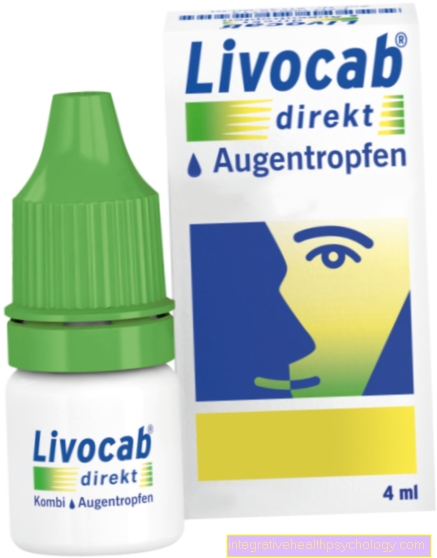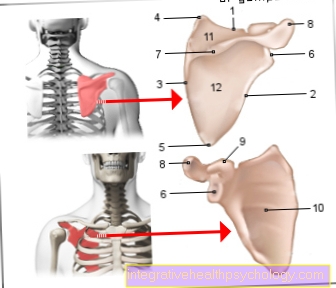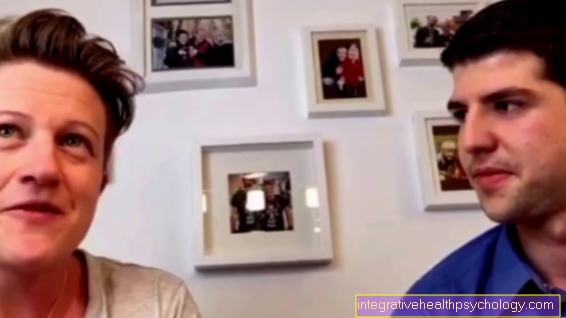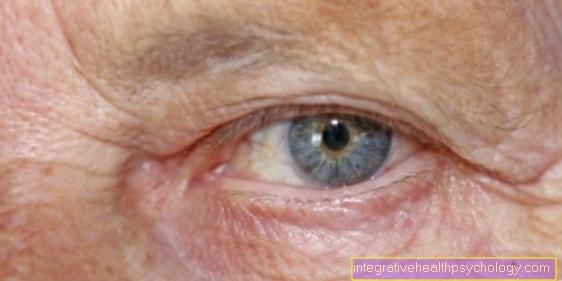Surgery for breast cancer
definition
In the surgical treatment of breast cancer, there are essentially two different methods. The older method is the so-called modified radical mastectomy. During this operation, the entire breast (glandular tissue and skin) and, if necessary, the pectoral muscle below, is removed.
Read more about this at: Mastectomy
The second and newer method is breast-conserving therapy (BET). It is used in 70% of all breast cancer patients. Only the tissue with the tumor and a small piece of skin are removed. The rest of the glandular tissue and skin are left. Both methods always involve the removal of lymph nodes from the armpit on the same side. How many lymph nodes are removed depends on whether there are tumor cells or not.

Indication for an operation
The operation is an important part of the therapy concept for breast cancer. This means that all patients, in whom no metastases (degenerations) are proven, always get an operation.Even with precancerous lesions that have not yet grown invasively, surgery should be performed early to prevent further degeneration. The surgical method has no influence on survival, which means that the two methods described above are equivalent.
In Germany, breast-conserving therapy is carried out in the majority of patients because it is less invasive than complete breast removal. However, there are some indications for complete breast removal. These include an unfavorable ratio of tumor to breast in large tumors, multiple tumors in the same breast or involvement of the skin / muscles. Further indications for this would be radiation treatment of the breast that has already been carried out, other contraindications to radiation and of course the patient's request.
Read more about different stages of breast cancer.
Preparation for the operation
Before the operation, the gynecologist provides a comprehensive explanation of the surgical methods and risks. In addition, as with other operations, a conversation with the anesthetist must be held in order to discuss the risks of the anesthesia and to clarify any risk factors. If the tumor in the breast cannot be felt, it will be found in the BET (breast-conserving therapy) marked with a wire to help you find it faster and better during surgery. A radioactive substance is also injected into the area around the tumor. This radioactive substance is transported to the local lymph nodes via the lymphatic drainage pathways and accumulates in the degenerated tissue in particular. The lymph nodes near the tumor can then be displayed with a special camera and removed during the operation.
Procedure of the operation
The operation is performed under general anesthesia and in the supine position. Only the affected chest, armpit and head are exposed, the rest is covered.
In the Breast-conserving surgery an arch-shaped incision is made over the palpable or wire-marked tumor within the breast. The tumor is then removed with a sufficient safety margin from the surrounding healthy tissue. The skin that lies above the tumor is also removed. Depending on the proximity of the tumor to the nipple, it will also be removed. The lymph nodes in the armpit are removed with a second incision if the tumor is too far from the armpit. At the end of the operation, the skin is sutured together without tension. A complex reconstruction of the breast is usually not necessary with this method, as the amount of tissue removed is relatively small.
In the modified radicals A mastectomy is a spindle-shaped incision made from the breastbone to the armpit so that it runs above and below the breast. Such an incision makes it easier to reconstruct the breast later. All of the breast glands and fatty tissue, as well as the skin and the nipple, are then removed. Furthermore, you remove the shell of the large pectoral muscle, which is located under the chest. The muscle itself remains undamaged and only needs to be removed if it is also affected by the tumor. Next, the fatty tissue in the armpit down to the armpit vein is removed. The operating field thus includes the chest and armpit. If radiation is not planned after the operation, a placeholder can be used where the breast once was, which is the first step for future breast reconstruction. With this method, too, the wound edges are sutured without tension at the end and a tube is inserted into the operating area so that any wound fluid can drain through this tube. With both procedures, a pressure bandage can be placed over the wound at the end to prevent excessive bleeding.
Follow-up care of the operation
Immediately after the operation, the patient is transferred to the recovery room, where the after-effects of the anesthesia and the operation can be clearly observed. Usually they are transferred back to the ward just a few hours later.
In the first time after the operation, it is also important to observe the wound secretion in order to rule out the possibility of major bleeding in the surgical area. In general, for both surgical methods, a period of 2-4 weeks is recommended. In addition, the patient should not go to the swimming pool or sauna, should not do sports that put a lot of strain on the affected side and should not lift anything heavy with both arms in order to ensure optimal wound healing.
Became a Breast-conserving operationAfter a certain period of time, the rest of the breast is irradiated and possibly also the armpit on the side. This is to prevent a second tumor from forming locally.
The complete removal of the breast however, irradiation is only carried out in special cases. However, the asymmetry of the upper body can lead to changes in posture with tension in the muscles, which is why physiotherapy may be necessary. To prevent lymphedema, which can result from the removal of the lymph nodes, the arm is raised after the operation and, if necessary, lymph drainage is carried out by the physiotherapist. It is advisable not to wear clothing that is too tight on your arm, to avoid the effects of heat and not to lift anything heavy with your arm.
Once the surgical therapy has been completed, further therapy options, such as chemotherapy, are discussed and carried out with the patient.
Length of hospital stay
How long you have to stay in the hospital after the operation cannot be said in general terms. Factors that influence the duration are general well-being, any complications that may occur during the course, the course of wound healing and the surgical method. If you opt for a BET, the hospital stay is on average shorter than with the removal of the entire breast. This means that the length of the hospital stay is very individual and can range from just a few days to a few weeks.
Risks of the operation
An operation under general anesthesia always has general risks that are not discussed here. Only the specific risks of the BET (breast-conserving therapy) and removal of the entire breast.
A significant risk with both surgical procedures is the incomplete removal of the tumor. In this case, a second operation or further treatment with radiation or chemotherapy must follow. Another risk is damage to neighboring structures, such as vessels or nerves. If a blood vessel is injured, bruises may form during or after the operation, which may have to be treated. This or damage to nerves can also result in pain after the operation. These can improve over time or can be treated specifically. As with other operations, there is a risk of thrombosis, as one lies for a long time during the operation and is not mobile as one would normally be during the further hospital stay.
Finally, there is the risk of infection of the surgical wound. This can have a very mild course, but can also lead to another operation in which the wound is cleaned and re-closed.
In general, it can be said that the risks mentioned occur less frequently with BET. The exception to this is the removal of the lymph nodes, which is the same for both variants. The main risk here is the development of lymphedema from the removed lymph nodes.
Pain after surgery
You don't always have to experience pain in the surgical area after the operation. If pain is stated, it is usually a so-called pain Wound painwhich is caused by the irritation of the tissue and usually subsides after a few days with the healing.
However, around 30% of patients still suffer from chest pain three years after the diagnosis, which can be explained by the development of chronic pain due to nerve injuries. This chronic pain is felt to be severe by few patients.
Read more about this under Breast cancer pain
Healing time
The wounds that result from the operation usually heal relatively quickly, so that you can already pull the stitches on about the tenth day after the operation. The smaller incisions in BET (breast-conserving therapy) also allow healing to proceed faster. Longer healing is possible in patients with wound healing disorders, for example due to diseases such as Diabetes mellitus, arteriosclerosis and Obesity or by taking certain medications, such as Immunosuppressants (suppress the human immune system).
You might also be interested in: Chances of a Cure for Breast Cancer.
Differences if chemotherapy was done before or after the operation
Neoadjuvant means that chemotherapy is carried out before the operation in special cases. This is the case in palliative situations, inoperable tumors or if it has already been determined before the operation that chemotherapy is necessary. In inoperable situations, chemotherapy hopes that the tumor will become smaller and therefore operable. In the best case, a pre-treated tumor will shrink. This can even go so far that it can no longer be seen in the imaging. They would still operate on him to make sure that the tumor is completely removed. In addition, the nature of the tumor can change as a result of the operation, so that it may no longer be clearly delineated as before.
How does the lymph node removal work?
Nowadays not all armpit lymph nodes are removed, only the so-called sentinel lymph nodes. These are the lymph nodes that are first affected when the tumor spreads. Instead of 10-15 lymph nodes as was common in the past, this method only requires one to five lymph nodes to be removed.
Before the operation, the sentinel lymph nodes are marked with a radioactive substance that is injected into the tumor area. With the help of a special probe, the sentinel lymph nodes can then be identified during the operation, as they emit the strongest signal. The marking is also possible with a blue color, which can be seen with the naked eye in the lymph nodes during the operation.
First, the surrounding fatty tissue in the armpit is carefully removed and large vessels and nerves are exposed. This is to prevent them from being accidentally injured. The sentinel lymph nodes are removed from the armpit and examined pathologically (it is determined whether cells show abnormal changes). If the sentinel lymph nodes are not infected by tumor cells, the remaining lymph nodes can remain in the body because the likelihood that the tumor has spread there is very low. If the sentinel lymph node is infected by tumor cells, at least 10 lymph nodes are removed from the armpit.
You can find further information under our topic: Sentinel lymph nodes
Pain in the arm
In the arm, the pain is caused by removing the lymph nodes. Here the pain can occur during wound healing. But there is also a risk that this pain will become chronic. By removing the lymph nodes, tiny, sensitive nerves are injured, which send a permanent pain stimulus to the brain. This pain is called neuropathic pain refers to what means nerve pain and is described as burning pain.
Of course, lymphedema can also cause pain due to the swelling of the tissue. But this goes back as soon as the swelling of the tissue is removed.
What are the scars?
If a breast-conserving operation is performed, a small scar appears on the breast where the tumor was removed. This scar is usually only a few centimeters. Depending on the location of the tumor, the lymph node removal can be done through the same incision, leaving only a scar. In other cases, a second incision must be made during the operation to remove the lymph nodes.
When the entire breast is removed, a scar usually arises, although it is larger than the scars on the BET (breast-conserving therapy).
Where are the scars?
In the BET (breast-conserving therapy) creates a small scar in the area of the chest. The location of the scar depends on where the tumor is located. Often times, the incision can be made in the side or lower area of the breast so that the scar does not reach the cleavage and is not in the direct field of vision.
In some cases, a second incision must be made to remove the lymph nodes in the armpit, which leaves a scar in the front area of the armpit.
Will be a complete removal of the breast performed this leaves a scar that runs horizontally from the breastbone to the armpit. The height of the scar is chosen so that no scar tissue can be seen in the cleavage.
When can a breast implant be inserted after breast cancer surgery?
A breast implant only needs to be used if the breast is completely removed. A placeholder can be used in the same operation, provided that there is no re-irradiation. Should post-irradiation take place, breast reconstruction can begin when the skin has recovered from the irradiation. Otherwise, the rule of thumb is that breast reconstruction can begin six months after the operation.
More information on breast reconstruction.





























